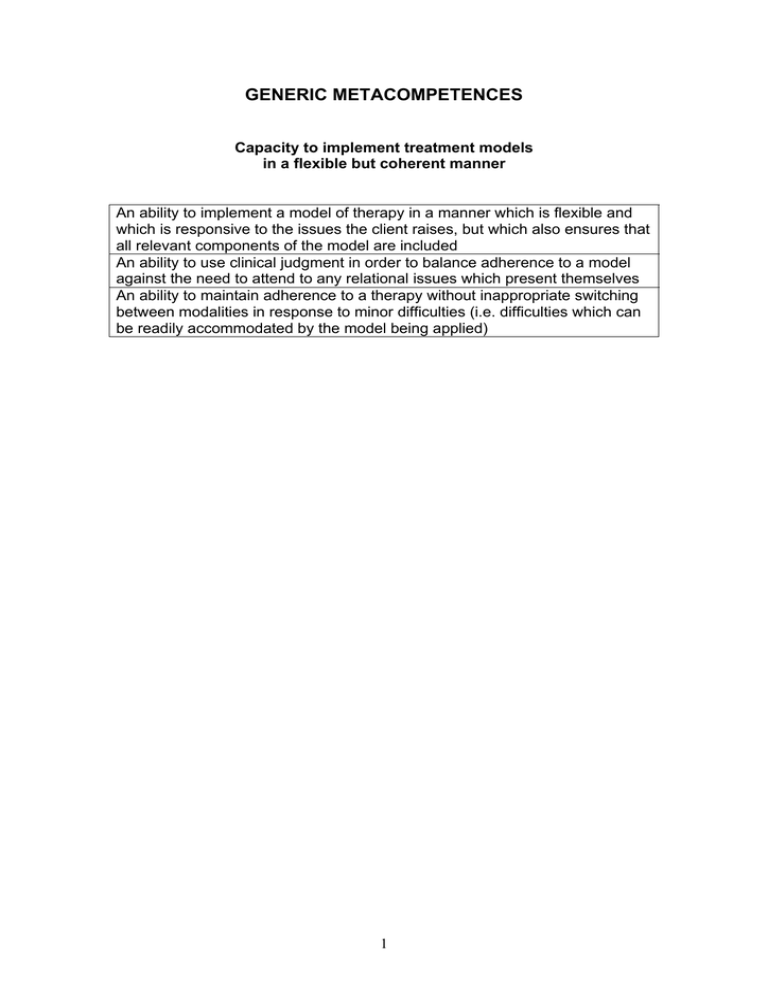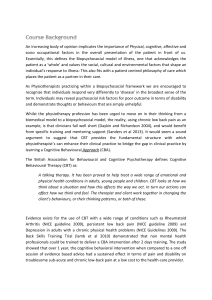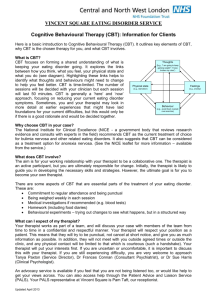GENERIC METACOMPETENCES
advertisement

GENERIC METACOMPETENCES Capacity to implement treatment models in a flexible but coherent manner An ability to implement a model of therapy in a manner which is flexible and which is responsive to the issues the client raises, but which also ensures that all relevant components of the model are included An ability to use clinical judgment in order to balance adherence to a model against the need to attend to any relational issues which present themselves An ability to maintain adherence to a therapy without inappropriate switching between modalities in response to minor difficulties (i.e. difficulties which can be readily accommodated by the model being applied) 1 Capacity to adapt interventions in response to client feedback An ability to accommodate issues the client raises explicitly or implicitly, or which become apparent as part of the process of the intervention: An ability to respond to, and openly to discuss, explicit feedback from the client which expresses concerns about important aspects of the therapy An ability to detect and respond to implicit feedback which indicates that the client has concerns about important aspects of the therapy (e.g. as indicated by non-verbal behaviour, verbal comments or significant shifts in responsiveness) An ability to identify when clients have difficulty giving feedback which is “authentic” (e.g. clients who respond in accordance with what they think the therapist wishes to hear, rather than expressing their own view) and discussing this with them An ability to be aware of, and respond to, emotional shifts occurring in each session, with the aim of maintaining an optimal level of emotional arousal (i.e. ensuring that the client is neither remote from or overwhelmed by their feelings) 2 Capacity to use and respond to humour An ability to use humour judiciously, understanding how it can be used as an aid to help clients (e.g. to normalise the client’s experience or to reduce tension), but also recognising its risks (e.g. of invalidating the client’s feelings, acting as a distraction to/ avoidance of feelings, or creating “boundary violations”) An ability to respond to client’s humour in a manner that is congruent with its intent, and responsive to any implied meanings 3 CBT SPECIFIC METACOMPETENCES Capacity to implement CBT in a manner consonant with its underlying philosophy Basic orientation An ability to base all therapeutic contact and conduct on a perspective which sees the world, including interactions with the therapist, from the perspective of the client’s beliefs and information processing strategies Capacity to form and maintain a collaborative stance A capacity to form a collaborative relationship with the client, based on an active stance which focuses on enabling the client and therapist to work as a team An ability to discuss and resolve any disruptions to collaboration An ability to balance the need to structure sessions as against the need to allow the client to make choices and take responsibility An ability to avoid implementing CBT in a manner which becomes didactic directive, intellectual or controlling Maintaining a problem solving perspective An ability to avoid seeing the client themselves as a problem, but to maintain a problem-solving approach to the client’s difficulties An ability to maintain a problem-solving attitude in the face of difficulties and frustrations Relationship between therapist and client An ability to detect unhelpful elements in the relationship (e.g. high levels of dependency and/or over-reliance on the therapist), and an ability to discuss and attempt to resolve them with the client 4 Capacity to formulate and to apply CBT models to the individual client An ability to implement the CBT model in a manner which is consonant with a comprehensive formulation that takes into account all relevant aspects of the client’s presentation An ability to hold the formulation in mind in order to anticipate and to respond to client’s needs in the context of applying the CBT model An ability to hold the formulation in mind in order to ensure that CBT is implemented in relation to the client needs, and hence in a manner: which is flexible and appropriately adapted which ensures that important aspects of the client’s presentation are acknowledged (and not ignored in order to simplify the intervention) which ensures that the intervention is not reductionist or simplistic 5 Capacity to select and skilfully to apply the most appropriate CBT intervention method An ability draw on knowledge of CBT models and methods and on clinical experience in order to select from the complete range of both behavioural and cognitive methods, and skilfully apply them in a manner which is: matched to the needs and capacities of the client applied at the appropriate stage of therapy 6 Capacity to structure sessions and maintain appropriate pacing An ability to maintain adherence to an agreed agenda and to ‘pace’ the session in a manner which ensures that all agreed items can be given appropriate attention (i.e. ensuring that significant issues are not rushed) An ability to balance the need to maintain adherence and pacing while being appropriately responsive to client need: An ability to structure the session in a manner which is congruent with specific issues (e.g. the client’s capacity to concentrate) An ability to balance the need to maintain an appropriate pace against following up important issues raised by the client: An ability to use clinical judgment to decide when issues needs to be pursued and when they could act to divert attention from the primary (and agreed) focus of the intervention 7 Capacity to manage obstacles to carrying out CBT An ability to work collaboratively with clients to identify beliefs that are potentially counter-therapeutic and that relate to a range of potential issues: a misunderstanding of the cognitive model (e.g. that CBT is only positive thinking), or difficulties the client is having in applying the model to themselves incapacitating positive or negative attitudes/beliefs expressed either explicitly or implicitly towards the therapist, (usually through direct discussion of relevant feelings and beliefs) An ability to work collaboratively with client behaviours that are potentially counter-therapeutic – for example, clients who: find it difficult to talk tend to talk too much and/or find it hard to stay focused invent or distort material are persistently late An ability to continue to work in a manner which is congruent with the CBT model when client’s symptoms/problems worsen An ability for the therapist to identify their own unhelpful cognitions, especially self-defeating thoughts relating to lack of client progress An ability to tolerate frustration and to remain task-focused (for example, in the face of slow progress) 8







